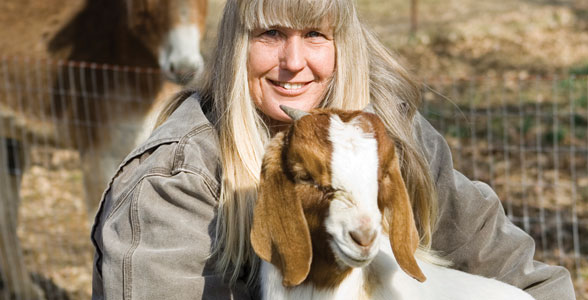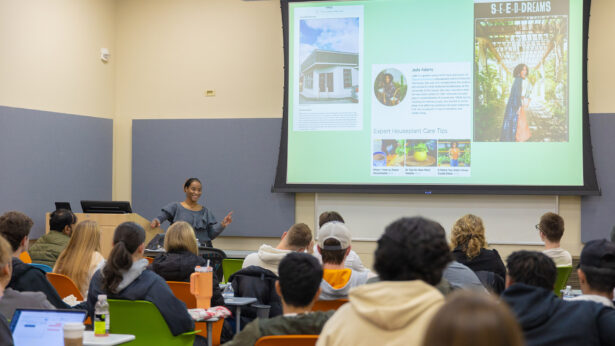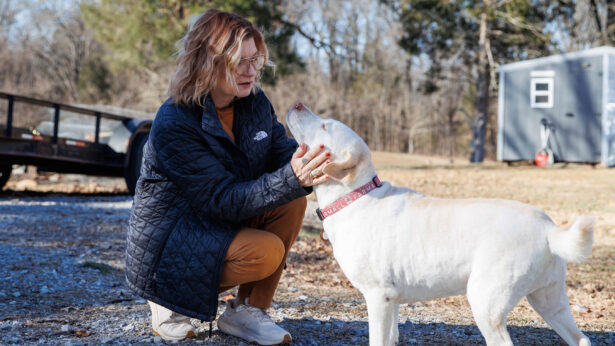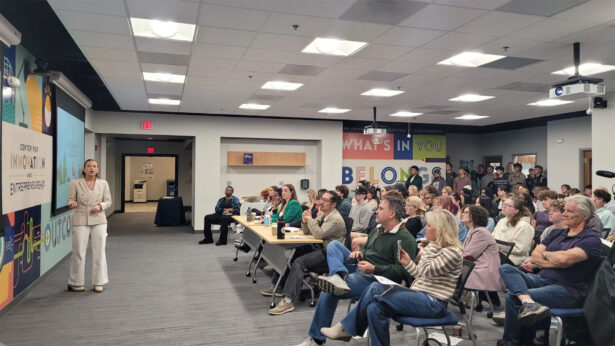Why would a retired police officer from Miami own a herd of goats? When you meet Deb Kidwell, it makes perfect sense. Kidwell is raising mules and a special breed of donkey called American Mammoth Jackstock on her farm in Weakley County, Tennessee. It’s her goats that literally clear the way for her growing livestock operation, Lake Nowhere Mule and Donkey Farm. Kidwell and her goats also are helping UT Martin improve management practices for other goat producers.
Kidwell is among a growing number of Tennesseans who raise goats for clearing land, producing meat and milk, creating breeding stock, and other pursuits. Tennessee Agriculture 2006, the state Department of Agriculture’s latest report and statistical summary, places the number of meat goats in the state at 103,000 head, up from 98,000 in 2005. The number of milk goats remained constant during the 2 years at about 6,200. The meat-goat numbers place Tennessee second behind Texas, the nation’s leading goat-producing state.
UT Martin opened its Sheep and Meat Goat Teaching/Demonstration Center in 2004. The center and the grant that funds the work with Kidwell are outgrowths of the 1996 Farm Bill, which included funds for revitalizing the U.S. sheep and goat industry.
Dr. Richard Joost, UT Martin professor of plant and soil science, directs the grant project. Assisting Joost are Dr. Janet Bailey (Knoxville ’04), veterinarian and assistant professor of animal science, and research associate Ben Neale (Martin ’01,’06). They are studying which forages are best for goats and how to market the animals more effectively. The project’s first 2 years were completed at the university’s teaching and demonstration center. This final year will include field days, forage trials, and other producer-related activities, some of which will happen at Kidwell’s Lake Nowhere Farm.
Several factors are driving interest in goats, including the financial opportunity created by an increasing segment of the U.S. population from cultures that traditionally grow goats, combined with Tennessee’s location. “Tennessee is a day’s truck drive to the entire Eastern seaboard, so we can ship things from Tennessee that a lot of people don’t have access to in those markets,” Joost says. “The majority of the population that eats goat, or has an interest in goat in their dietary habit, is located on the Eastern seaboard.”
Raising goats requires fewer acres than traditional livestock. “In our time, people don’t usually own hundreds and hundreds of acres of land,” Bailey says. “You can still raise animals, but you don’t have to have forty or fifty acres of land to do it with a small goat herd.” Bailey even has several current students who are getting in on the act and raising goats for profit.
Enter Deb Kidwell, seemingly one of the most unlikely of people to own goats. Kidwell, who has a fine arts degree and was a patrol officer for 23 years, also served as director of emergency management for the police department after Hurricane Andrew in August 1992. Following her retirement in 2004, she and her husband, Jim, moved to Northwest Tennessee, where they purchased the 110-acre tract known as Lake Nowhere. The Kidwells wanted to clear land and add fencing for livestock, which led them to purchase goats to clear the brush. Eventually the herd became 100-percent registered Boers, a South African breed.
Kidwell learned about the goats, which can grow to 300 pounds, from a Paducah, Kentucky, television show. Her father bred horses, so she was familiar with raising animals. But there’s “a lot of difference” between raising horses and raising goats, she laughs.
Kidwell fences off different areas of her farm and brings in the goats to eat the brush by “browsing”–their preferred feeding method. She follows the goats, clearing trees and the remaining debris. Pasture is then sown for the donkeys and mules, and the clearing process moves to the next area. “They’re like the advance guard, I guess you could call them,” she says of her goats.
“Boers are a meat goat as opposed to a dairy goat,” Kidwell says. “But none of ours are destined for barbecue, we hope. We prefer to sell them as breeding stock and pets. Most of them thus far have gone as pets.” In her situation, the goats have done their primary job of clearing land, so she’s no longer expanding the 17-head herd.
UT Martin is conducting warm-season grazing trials at Kidwell’s farm, where researchers are growing forbs–or weeds–with high tannin content as a potential environmental control for parasites. When goats are confined to very small pastures, parasite incidence increases and the parasites become immune to repeated treatment. The researchers already have studied other forages such as lespedeza, chicory, white clover, and Illinois bundle-flower.
Kidwell says she thinks UT Martin’s research may help keep potential producers from launching into goat farming without enough information, as has happened in the past with emus and ostriches. She says goats’ reputation as “hard keepers” happens because people don’t understand upfront the ins and outs of raising the animals.
Besides production challenges, Joost says goat owners often aren’t prepared for the marketing realities of the business. Shaun Jackson (Martin ’07), UT Extension 4-H agent in Wayne County, studied the issue with funding from the grant.
“Shaun’s major finding is that forty-nine percent of all goat producers in Tennessee market their goats at live auction whenever they’ve got goats ready, so there’s no marketing to it at all,” Joost says. “And therein lies the major problem for the growth of the industry. Until they [producers] get a consolidated, planned approach to marketing, they’re not going to gain the best price or have a consistent supply of animals.”
Jackson’s thesis also compared cultural and religious holidays, examining the number of animals available for Cinco de Mayo, the start of Ramadan, and Christmas, among others. Some holiÂdays require different-aged animals, so timing is important. “It’s kind of hit and miss right now,” Joost said. “There’s not a good [marketing] plan in place.”
The other major thesis finding was that producers want a goat-slaughter facility in West Tennessee. Both Haywood and Shelby counties have been mentioned as possible sites. “There’s some interest, some growth, and we’re trying to facilitate as much of that as we can, trying to get the producers information they need to be able to make this all work together,” Joost says. Although Kidwell doesn’t sell her goats for meat, her participation in the UT Martin grant will help those who do. She says simply about her goats, “They have a job to do.”
Joost and his fellow UT Martin researchers have a job to do, as well. Their work is helping to improve goat production, which could enhance economic opportunities for current and future producers. Thanks in part to Deb Kidwell and Lake Nowhere, goat production is headed somewhere positive in West Tennessee.



